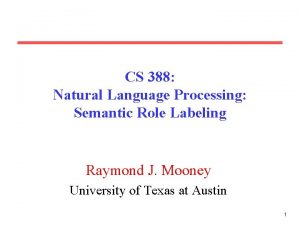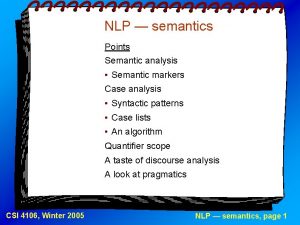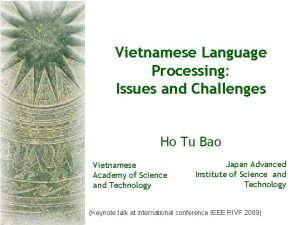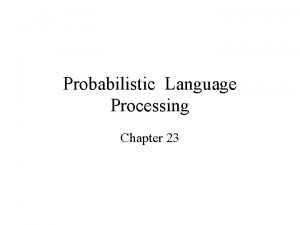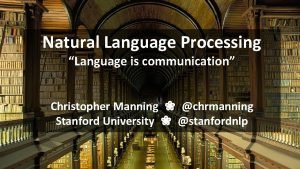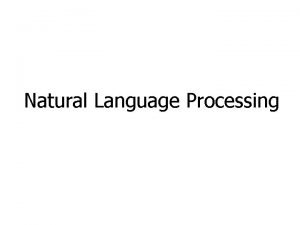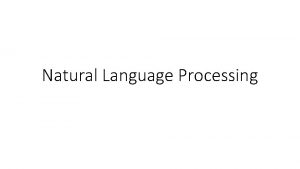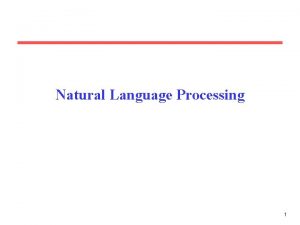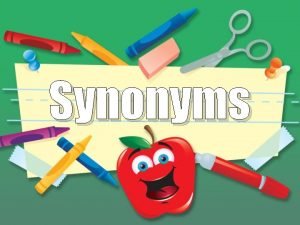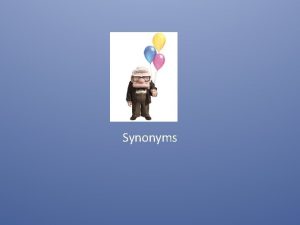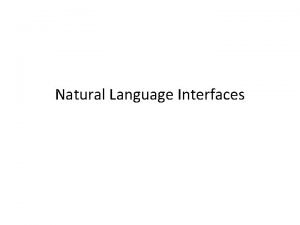NLP Natural Language Processing Semantic Similarity Synonyms and











- Slides: 11

NLP

Natural Language Processing Semantic Similarity

Synonyms and paraphrases • Example: post-close market announcements The S&P 500 climbed 6. 93, or 0. 56 percent, to 1, 243. 72, its best close since June 12, 2001. The Nasdaq gained 12. 22, or 0. 56 percent, to 2, 198. 44 for its best showing since June 8, 2001. The DJIA rose 68. 46, or 0. 64 percent, to 10, 705. 55, its highest level since March 15.

Synonyms • Different words (and also word compounds) can have similar meanings. – tepid and lukewarm have very similar meanings and can be substituted for one another (tepid water vs. lukewarm water). • True synonyms are actually relatively rare. – even though big and large are often thought of as synonyms, consider the difference between Big Leagues and Large Leagues. • The verbs sweat and perspire also near synonyms. – However, they differ in their frequency of use and the type of text in which they are likely to appear.

Polysemy

Polysemy

Polysemy • Polysemy is the property of words to have multiple senses. • For example, the noun book can refer to the following: – – – A literary work (e. g. , “Anna Karenina”) A stack of pages (e. g. , a notebook) A record of business transactions (think “bookkeeper”) A record of bets (think “bookmaker”) A list of buy and sell orders in a financial market

Polysemy • The same word can also have multiple parts of speech, each with its own set of senses. For example, the word book, as a verb can mean “make a reservation for” or “occupy”. • The different senses of the same word don’t have to be equally frequent. • Some of the senses may overlap (e. g. , the first two senses of book on the previous slide). That’s partially why different dictionaries list different sets of word senses for the same word. – “My favorite books are Anna Karenina and my father’s checkbook” • Some words can be highly polysemous (e. g. , the verb “get” has at least 35 different meanings, according to Wordnet).

Other Semantic Relations • Antonymy (near opposites) – raise-lower • Hypernymy – a deer is a hypernym for elk • Hyponymy (the inverse of hypernymy) • Membership Meronymy: – a flock includes sheep (or birds) • Part Meronymy: – a table has legs

Synsets • Semantic relations hold between word senses, not between words. • Examples: – the antonym of hot can be either mild or cold (or unattractive) depending on the specific sense of hot. – the immediate hypernym of bar can be one of the following, among others: room, musical notation, obstruction, profession, depending on the sense of bar. • The term synset is used to group together all synonyms of the same word. If a word is polysemous, it may be associated with multiple synsets.

NLP
 Natural language processing nlp - theory lecture
Natural language processing nlp - theory lecture Natural language processing lecture notes
Natural language processing lecture notes Language synonyms
Language synonyms Nlp text similarity
Nlp text similarity Semantic role labeling nlp
Semantic role labeling nlp Semantic markers examples
Semantic markers examples Similarity synonym
Similarity synonym Natural language processing vietnamese
Natural language processing vietnamese Probabilistic model natural language processing
Probabilistic model natural language processing Markov chain natural language processing
Markov chain natural language processing Language
Language Pengertian natural language processing
Pengertian natural language processing




